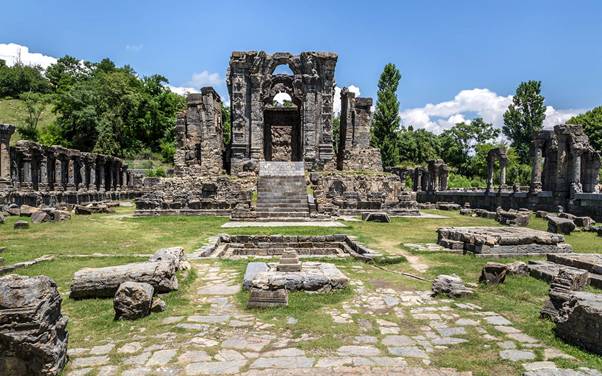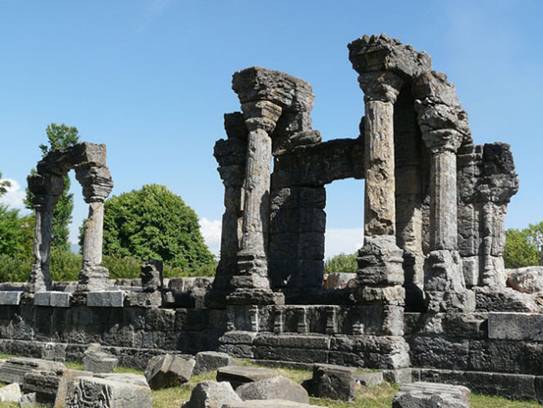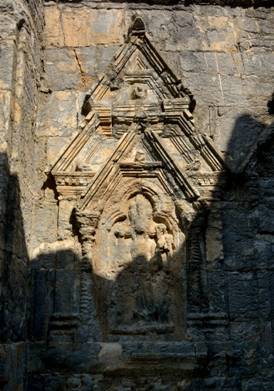Chronicler Kalhana in his work Rajatarangini provides detailed information about the Karkota dynasty which held the occupation of the Kashmir valley. Karkota dynasty took power in the valley of Kashmir in the first half of the 7th century CE.
Karkota dynasty was founded in 625 CE by Durlabh Vardhana, contemporary of Harsha of the Pushyabhuti dynasty. Hieun Tsang, Chinese pilgrim visited Kashmir during Durlabh’s reign. The greatest ruler of the dynasty was Lalitaditya Muktapida who ruled from 724 to 761 CE. His accession to the throne marked an era of glory and prosperity, which Kashmir failed to regain even after centuries. His prolonged wars for expansion like those of Alexander earned him the title of Alexander of Kashmir.
Lalitaditya’s aspiring nature mentioned in Rajatarangini-
For rivers which have set out from their own region the ocean is limit but nowhere is there a limit for those who are frankly aspiring to the conquerors.
Lalitaditya launched a policy of expansion and extended the power of Kashmir beyond its boundaries. Lalitaditya was able to vanquish the Turks, Tibetans, Kambojas, and others. The political conditions of the subcontinent provided him an impetus to expand his political dominions. The powerful Gupta empire in the North was at the edge of decline.
In Deccan, the Pallava empire was fading out and Chalukyas of Badami were dying of military exhaustion. In the west, the Sassanian empire collapsed. The Chinese under T’angs who had extended their empire to the west conquering Kutcha, Khotan, Khorasan, and Kashghar were losing control over the provinces.
The downfall of T’ang rule led an influx of army men to Kashmir. Lalitaditya recruited the Chinese military men and utilized their political and martial techniques, which were far superior to his contemporaries. His conquests were led by a reputed commander Cankunya, who served as a supreme commander-in-chief of T’angs under the title of Can-kiun.
With a powerful trained military, Lalitaditya embarked upon his military conquests in action. The extensive conquests made the Karkota kingdom of Kashmir, the most powerful empire of India after the Guptas. In proximity to Kashmir was the empire of Kanauj under Yasovarman, the successor of Harsha of the Pushyabhuti dynasty. Yasovarman submitted and the whole territory was brought under the Karkota empire. With this victory, he became the master of Kanuaj.
To assert his rights, he marched towards East attacking king Jivitagupta of Gauda, a region comprising Bihar and West Bengal, and advanced up to the seacoast of Orissa.
Lalitaditya allied with the Chalukyas in Deccan and overran Rashtrakuta territories. Lata (Southern Gujarat) was brought under Kashmir. On his way back, he passed through Gujarat, Kathiawar, Malwa, Marwar, and forced Maitrakas of Valabhi and Mauryas of Chittorgarh to submit.
After the victories in the south, Lalitaditya turned his attention to the areas bordering North of Kashmir. According to the sources, his empire extended to Karakoram range controlling the caravan routes from India to China. He easily brought Dard Desha (Dardistan) to the Tukhara country (Turkestan) under him.
Tibetan invasion of Kashmir in 747 CE is said to have forced him to turn back. Chinese Annals mention that Laitaditya sent an ambassador to the Chinese court of Yuen Tsun to seek aid from the emperor against the common enemy Tibetans. Chinese Emperor and Laliaditya despatched approximately 200,000 men against Tibetans and inflicted a crushing defeat. Kalhana and Alberuni mention that Kashmiris observed second of Chaitra as a day of Lalitaditya’s victory over the Tibetans.
The remarkable military conquests of Lalitaditya earned him the title of Alexander of Kashmir by modern writers. Lalitaditya’s ambitions of conquest resulted in his death. He lost his life in a distant expedition to North. Kalhana mentions two legends about his death. According to one version, Lalitaditya perished through excessive snow in a country called Aranyaka (modern Afghanistan). Another version made him end his own life to escape being captured when separated from his army and blocked on a difficult mountain range.
Lalitaditya undertook public welfare works such as the construction of canals and irrigation projects. He built a big vihara (monastery) and Buddhist temple at Hushkapura (modern Ushkur). Towns such as Suniscatapur, Lalitapur, Darpitapur, Lokpunya (modern Lokbhavan) were built by him. However, Lalitaditya’s greatest constructions are the city of Parishapura and the temple of Martand.
The temple was destroyed in 15th century CE, on orders of sultan Sikander Butshikan, its ruins still stand tall. Ruins of the temple of Martand (Sun) which the king had constructed is a striking object of ancient Hindu architecture. Located in the Anantang district, the temple is the oldest sun temple in India. The temple is 60 feet long and 38 feet wide, its height is approximately 75 feet. The entrance or gateway of the temple stands in the middle of the western side of the quadrangle, and it is of the same width as the temple itself. It contains 18 staircases on the front side. There are about 84 pillars many of which lie prostrate on the ground. Its base consists of motifs of different gods and goddesses especially Vishnu and Shiva. The above portion of the main temple consists of images of goddess Ganga and Yamuna. The temple contains an inscription of 6 lines perhaps in Sharda script of an unknown authority on the base wall of the subsidiary shrine.
Lalitaditya’s successors were not as competent as him and the acquired territories began to assert independence under feudatories after his death. Short reigns, disputed successions, civil war, aimless expeditions such as those of king Jayapida soon reduced the Karkota dynasty to a mere shadow.
Lalitadtiya was not only a tireless warrior and great conqueror but also an eminent sponsor of learning art and architecture. His virtues as a humane conqueror, patron of art and architecture, and thorough sponsorships to scholars rank him as one of the greatest kings of India.

Image credit- https://www.flickr.com/photos/hindiwater/14737083314

Image credit- https://www.travelistly.com/stories/martand-sun-temple-in-kashmir

Image credit- https://www.flickr.com/photos/nileshkorgaokar/21730778383

Image credit- https://www.flickr.com/photos/nileshkorgaokar/22351876465/in/photostream/
Bibliography
-
P.N. K. Bamzai, Culture and Political History of Kashmir, Volume 1, M D Publications Pvt Ltd, New Delhi 1994
-
Poonam Dal Dahiya, Ancient and Medieval India, Mc Graw Hill Education (India) Private Limited, 2017
-
Pallavi Singh, Lalitaditya Muktapida: A Great Warrior, Bhairavi, 2018
-
Arif Ahmad Dar, Ancient Hindu Temple Architecture of South Kashmir From 3rd Century A.D. to 10th Century A.D.,Laxmi Book Publication, 2018.
